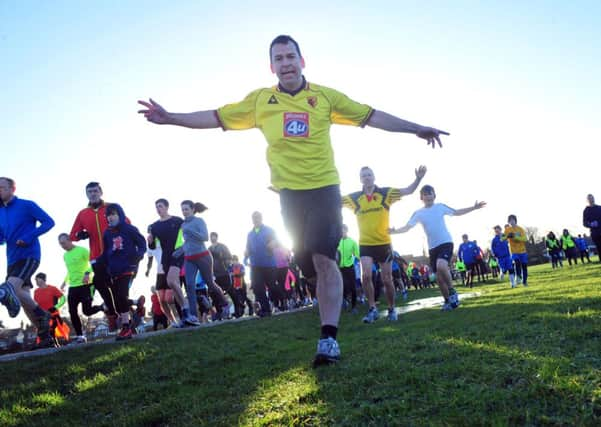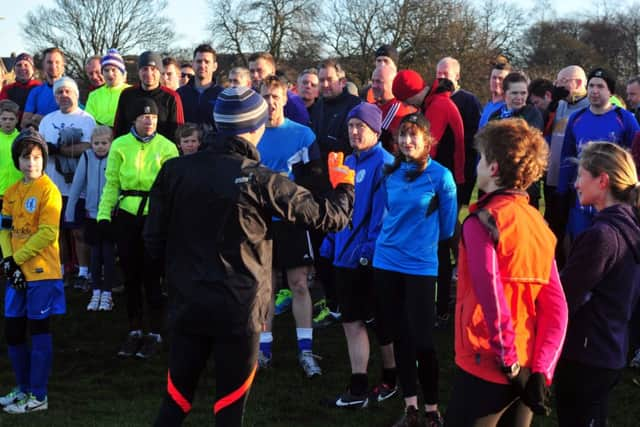Running in the family


It’s 8.30am one Saturday morning, Harrogate’s Stray is shrouded in fog and the car thermometer has just climbed to a miserly 3C. You’d think there was very little stirring on such a dismal day. You’d be wrong.
Half an hour later the area is thronged with figures of all shapes, sizes and ages, preparing for what has become an increasingly popular adrenalin fix. It’s a scene repeated at 23 other venues across Yorkshire and Humberside alone, throughout the UK and as far away as Australia, at weekly parkruns.
Advertisement
Hide AdAdvertisement
Hide AdSuch has been the parkrun phenomenon that between 75 and 100 more UK venues are expected to stage weekly events by the end of this year. They include the world-famous setting of Fountains Abbey and Studley Royal as the National Trust seeks to encourage sport and general wellbeing in the community by opening up its sites to more activities.


Parkrun started at Bushy Park in Teddington in 2004 with a mere 13 runners toeing the line. The venue has just staged its 500th event and its record field is 1,184. Leeds’s Woodhouse Moor staged the first parkrun outside London in 2007 and organisers elsewhere in Yorkshire got in on the action, with some events now even staged on Christmas Day.
Adam Prentis, 50, event director of Harrogate’s parkrun, attributes its success in the town – it can now often attract more than 300, having started two years ago – to its community base. Prentis, who runs his own IT consultancy, can spend many hours a week on parkrun, but is a volunteer, as are the rest of the local event’s helpers.
“Every parkrun has its own very special community,” he says, having previously sampled the event in Leeds before becoming the driving force behind the Harrogate version. After encouraging runners at the start, he often does the run itself and, on this dismal winter day, was planning to run a half-marathon 24 hours later.
Advertisement
Hide AdAdvertisement
Hide AdThe community-based, family-inclusive nature of parkrun is a theme echoed by Wendy Marks, a 46-year-old property manager, who regularly acts as race director supporting Prentis. “The run encourages people who are scared to do a race,” she says. “It’s called a run rather than a race and the three-lap circuit means people can easily pull out if they find it too much. But is also attracts the very fast guys.”
The social side of the event is very important to Harrogate Harriers member Marks, whose own running CV includes 23 marathons and 69 parkruns. “We have a coffee in town afterwards and you can get to know people socially. I’ve made quite a few groups of friends who you can then go out running with.”
That reviving coffee may seem a good way off on the start line, but there’s a conscious effort to put first-timers at ease. On this cold winter’s morning, runners were urged to shake hands with the person next to them.
While evangelical talk of inclusivity, community, the parkrun family and running journeys may grate with some, the event ticks a lot of society’s 21st century boxes (even down to the lower case branding in the ‘p’ of parkrun). Take family friendliness. Youngsters under 11, accompanied by adults, can be seen joining in the fun and there’s even a place for Fido, as long as he’s on a lead. And what about, for example, sustainability? Well, parkruns stay away from cluttered roads whereas mass participation marathons and half-marathons may cause considerable disruption for drivers.
Advertisement
Hide AdAdvertisement
Hide AdThere is, though, a decidedly un-21st century aspect to parkruns – they are free. Whereas entry fees for road races continue to rise – marathons can cost more than £40 – the free parkrun has a special attraction if you’re looking to offset the cost of those £100 running shoes.
Once that fancy footwear has pushed you through the parkrun pain barrier you can check your result the same day on a detailed website. As well as usual time and position there’s something rather clever called age-graded performance which, simply put, compares your time with the best for your age and gender, giving you a percentage. So if you’re a sprightly 68-year-old, you could tell yourself you did better that that young whippersnapper in his 20s who finished an apparently dispiriting distance ahead.
Putting the youngsters in their place at Harrogate is 65-year-old Ben Grant, who scored 88.94 per cent by clocking 18 minutes 41 seconds when he was a mere youngster of 64. Grant, a world veteran mountain running champion who topped the national over-65 10km rankings last July, finds parkruns a very convenient way of getting in a run, and clearly enjoys the informality.
He said: “I get up on a Saturday morning and it takes 15 minutes to walk here from home. I bring a flask and can drink some tea on the way if I want and finish it walking back afterwards.”
Advertisement
Hide AdAdvertisement
Hide AdGrant also acts as a volunteer. “You’re putting in some of what you take out, plus I like to be here as I know a lot of people doing the run or volunteering.”
At the other end of the running spectrum NHS support worker Sarah Winslow, 42, was enjoying her first parkrun on that miserable morning. She crossed the line in 39 minutes 37 seconds, finishing 302nd in the field of 308. Was she glad she’d turned out to battle through the sticky conditions? “It was fab,” she said, seconds after crossing the line. “Everybody was friendly and it was a very welcoming event for someone new.”
It may have been murky on the Stray that morning but you couldn’t fail to make out the overwhelming enthusiasm.
To register for parkrun, or to check out your nearest venue, visit www.parkrun.org.uk
The first Fountains Abbey and Studley Royal parkrun takes place on Saturday, March 1, at 9am.